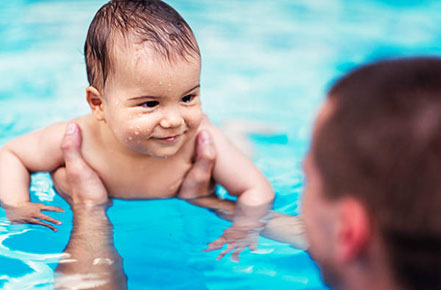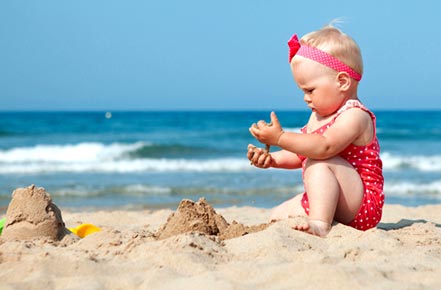Holding a baby near a father or a mother turns out to be extremely important from the viewpoint of mental health and development. On the other hand, incorrect carrying may do more harm than good for kids. Thus, you need to know basic recommendations and misconceptions about how to hold baby that are indicated in this post. Don’t worry: we are going to give you all the necessary information to make this task simple. Don’t miss a word!
Which Are the Main Benefits Of Holding Your Baby?

When a child appears in a family, many new parents are truly puzzled trying to understand what they should do with that little miracle to avoid any harm for both physical and mental health. Kids are unique and have their own peculiarities of development but there is something in common. All parents may be divided into two camps. The first ones insist on the necessity of holding a child everywhere while others reject this. In fact, there truly exist numerous benefits of babywearing. Among the key ones the following aspects are distinguished:
- Constant contact with parents.
Psychologists indicate that baby carrying leads to the better emotional development of an infant. Kids feel themselves protected and emotional contact between parents and their children becomes tougher. We understand kids’ signals and know better what they wish. That is especially important for premature infants.
- Development.
Kids are being developed under the influence of the surrounding world. Their nervous system develops as well. Holding a baby, their inner world is connected with parents’ one and therefore an infant takes part in everything parents do. Thousands of memories and reflections are collected into a kid’s brain like numerous mini-movies.
- Adaptation to the outside world.
The process of a kid’s adaptation to the outside world is frequently stressful for infants whose systems are immature. Everything is so strange and frightening. A child carrier creates an effect of being in the womb. Thus, kids better adapt to the world around themselves protected.
- Less painful cramps.
Children undergo the period of what they suffer from cramps. Carrying makes cramps significantly less painful because a carrier provides the massage effect and keeps an infant in the warm environment.
Which Ways of Carrying a Baby Do Exist?
Parents wish their child to develop physically and mentally therefore they are interested in how to carry a baby correctly. There exist several ways while the choice should depend on your kid’s age. All infants undergo several main growing stages and those periods are as follows:

During this period infants begin to smile, react to their parents’ voices and are preparing for investigating the world. Cradle position is the best for carrying. This position reminds the one for nursing.
The period is characterized by emotional contact with a family. Kids perceive the world, touch everything and try to communicate. On the other hand, children’s vision is in the initial stage of developing, therefore, distinct objects cannot be identified. Selecting a baby carrier for that period, a face-to-face position should be preferred. Looking at mom’s or dad’s face, kids feel calm and protected.
A hipseat baby carrier becomes the best solution for parents who are interested in how to hold a kid at this period. The emotional contact between a kid and a mom or a dad is still tough but the position allows a little one observing surrounding objects and collecting knowledge about the outside world.
Kids become more and more active and demand freedom of motion therefore backpack carriers can be used. Children distinguish the environment and distinct objects and that’s why such a position is the best for perceiving the world.

Diverse array of baby carriers’ types: which one to select?
The contemporary market offers multiple goods for children and carriers are not the exception. What is a baby carrier in general? That means a special construction that holds a kid and provides freedom to parents. Deciding how to carry a baby correctly, parents are suggested to purchase numerous types of those ‘devices’. Among the most widespread ones the following types are distinguished:
- Wrap:
A baby wrap is considered as the simplest way of a carrier for babies. Parents are able to choose an appropriate fabric that is the most comfortable. Moreover, a child’s position can be regulated as well therefore wrap is suitable for kids of different age holding. Cons exist as well and lie mostly in difficulties with proper tying.
- Sling:
Sling is understood as the best solution for those who are looking for an infant carrier. Holders of that type are offered in different constructions: ring slings, scarf slings, Mei Tei slings. Purchasing the best ring sling becomes frequently the key task for new parents as the construction is understood as the most convenient one. Ring slings are easily adjustable and suitable for holding a baby of different ages.
- Kangaroo:
A kangaroo for a kid is a widespread type of carrier as well but such a solution is suitable for kids aged over 6 months. Moreover, those holders are rather expensive.
Are baby carriers safe enough? Widespread misconceptions
Looking for an answer on how to carry a baby correctly, new parents worry about the health of their little ones. There can be pointed out the following misconceptions that concern holding a baby:

- My child cannot endure holders.
In fact, a carrier for a baby imitates the position in mom’s or dad’s arms; therefore kids feel completely comfortable. Moreover, holders give kids more freedom and open the world for them.
- Baby carriages are better from the viewpoint of physical development.
That is absolutely false. Kids are developing physically outside both carriages and holders. Comparing carriages and carriers, those are equally comfortable for babies while contemporary holders are convenient for parents foremost being multifunctional.
- Parents are afraid that babies may fall out of a carrier.
This fear may concern wrap type while slings are understood as safe carriers. Those constructions remind hammocks where kids are placed safely. Parents just should understand how to wear baby sling. Referring to carriages those are less safe than slings.
- Babies should sleep on the hard surface to avoid spinal curvature.
In the womb babies are crooked and that is their natural position therefore slings are perfect for infants providing them a convenient position. At the age of over 6 months baby holding head up is more natural.
- Babies are getting used to be always in the arms.
Slings cannot be compared to being in the arms as baby carriers give kids more freedom. Thus, your little ones may get emotional and physical contact on the one hand and to learn the outside world on the other hand.
- Kangaroo for baby is absolutely enough.
Definitely not! Parents frequently purchase not one baby holder no matter who is responsible for a kid carrying. For instance, a sling is understood as the best baby carrier for dad and mom as well when your little one is under 6 months.
Thus, misconceptions are rather numerous and our task is to remove those myths to provide you and your precious kid maximal comfort. Remember that the more responsible you are in holding a baby the more positive the influence for mental and physical health will be.
Using a baby carrier appropriately: a step-by-step guide
Parents wish to know how to put on a baby sling or other holding constructions to provide kids maximal safety and comfort. To avoid any mistakes in wearing those constructions follow our guideline:
- Fold a sling in the half.
- Thread a tale of a sling into rings or other fixing elements.
- Spread rings and thread a tale into the second one once again.
- Spread the fabric equally into rings. The better fabric is spread the more convenient a sling will be regulated.
- Place a sling rings into the infraclavicular region. A sling can be worn on any shoulder but specialists recommend changing them regularly.
- Spread a sling fabric on your shoulder and back. The fabric shouldn’t twist.
- Regulate a sling by its tale for having an appropriate length.
- Put a baby stomach-down on the other shoulder (free from a sling) and take your kid’s legs by the other hand.
- Place a child in the position you hold him usually in the arms.
- A sling should be placed in popliteal plane while the fabric should be spread till a kid’s head.
- Remember that the fabric should not cover a kid’s face and nose. You need to control the fabric constantly.
- A sling should be strained on the back. Parents are expected to feel a construction strained. The odd fabric should be pushed through a ring to fix the position.
In case of placing a child into M-position (vertical) a sling keeps popliteal plane as well because a kid’s hip joints and back are not formed completely. Putting on a child carrier is not a complicated task. Parents just need some practicing.
Conclusion

Parents who ask themselves a question can you hold a baby too much should understand that the golden middle is a key for success. Using different carrier types they make a contact and interaction between a kid and parents much stronger while on the other hand infants demand some freedom as well to develop and investigate the world.
Wishing to get the most qualitative carrier types and other products, visit parenthoodroutine.com where accessories for both physical and mental health and development are suggested. Which models of kid holders do you prefer and how much time your little ones spend with you?










